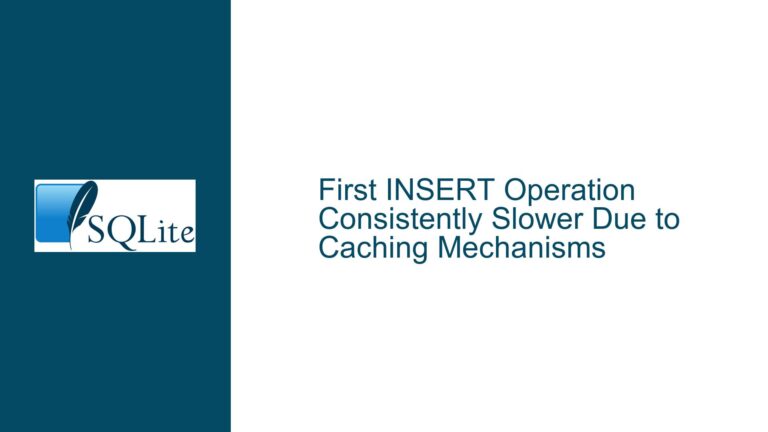Optimizing Repeated Calls to Deterministic User-Defined Functions in SQLite
Understanding the Redundant Execution of User-Defined Functions in SQLite Queries
When working with SQLite, user-defined functions (UDFs) can be incredibly powerful tools for extending the database’s capabilities. However, their use can sometimes lead to inefficiencies, particularly when the same function is called multiple times within a single query. This issue arises because SQLite, by default, does not cache or reuse the results of UDFs within the same query execution, even when the function is deterministic. This means that if a UDF is referenced multiple times in a query—such as in both the WHERE clause and the ORDER BY clause—it will be executed separately for each reference, leading to redundant computations.
For example, consider the following query:
SELECT id FROM table WHERE myfunc(id) > 10 ORDER BY myfunc(id);
Here, myfunc(id) is called twice: once for filtering rows in the WHERE clause and again for sorting the results in the ORDER BY clause. If myfunc is computationally expensive, this redundancy can significantly degrade query performance.
The problem is compounded when the function is deterministic, meaning that for a given input, it always produces the same output. In such cases, one might expect SQLite to optimize the query by calling the function only once per unique input and reusing the result. However, as of the current implementation, SQLite does not automatically perform this optimization, even when the function is explicitly marked as deterministic using the SQLITE_DETERMINISTIC flag during registration.
This behavior stems from SQLite’s design philosophy, which prioritizes correctness and simplicity over aggressive optimization. While SQLite does employ certain optimizations for deterministic functions—such as moving constant expressions out of loops—it does not currently track and reuse previously computed results for non-constant expressions within the same query. This limitation can lead to unnecessary computational overhead, especially when dealing with large datasets or complex UDFs.
Why SQLite Recomputes Deterministic Functions and When It Doesn’t
To understand why SQLite recomputes deterministic functions within the same query, it’s essential to delve into the database’s internal mechanisms and the role of the SQLITE_DETERMINISTIC flag. The SQLITE_DETERMINISTIC flag is used to indicate that a UDF will always return the same result for the same input, regardless of external factors such as time or database state. This flag enables SQLite to apply certain optimizations, such as evaluating the function once for constant arguments and reusing the result throughout the query.
However, these optimizations are limited in scope. Specifically, SQLite only caches the results of deterministic functions when the arguments are constants. For example, consider the following query:
SELECT id FROM table WHERE myfunc(42) > 10 ORDER BY myfunc(42);
In this case, since 42 is a constant, SQLite can evaluate myfunc(42) once and reuse the result for both the WHERE and ORDER BY clauses. This optimization is possible because the function’s input does not vary across rows.
In contrast, when the function’s argument is derived from a column value, as in the original example (myfunc(id)), SQLite treats the argument as non-constant. Consequently, the function is evaluated separately for each row in both the WHERE and ORDER BY clauses, even though the result for a given id is the same in both contexts. This behavior occurs because SQLite’s query planner does not currently track and reuse previously computed results for non-constant expressions within the same query.
It’s worth noting that this limitation is not unique to SQLite. Many relational databases face similar challenges when optimizing queries involving UDFs, as the database must balance the potential performance gains of caching function results against the complexity and overhead of implementing such optimizations. In SQLite’s case, the decision to avoid aggressive caching of non-constant deterministic function results is rooted in the database’s lightweight and modular design, which prioritizes simplicity and reliability over advanced optimization techniques.
Strategies for Minimizing Redundant Function Calls in SQLite Queries
While SQLite does not automatically optimize queries to minimize redundant calls to deterministic UDFs, there are several strategies that developers can employ to achieve this goal manually. These strategies range from restructuring queries to leveraging advanced SQLite features such as Common Table Expressions (CTEs) and expression indexes.
1. Using Common Table Expressions (CTEs) with MATERIALIZED
One effective approach is to use a CTE to precompute the results of the UDF and then reference the precomputed results in the main query. This technique ensures that the function is called only once per row, regardless of how many times the result is referenced in the query. For example:
WITH cte AS MATERIALIZED (SELECT id, myfunc(id) AS x FROM table)
SELECT id, x FROM cte WHERE x > 10 ORDER BY x;
In this query, the CTE cte computes myfunc(id) for each row in the table and stores the result in the column x. The main query then filters and sorts the rows based on the precomputed values in x, eliminating the need to call myfunc(id) multiple times.
The MATERIALIZED keyword ensures that the CTE is evaluated before the main query, which can improve performance by preventing the CTE from being reevaluated for each reference in the main query. However, it’s important to note that materializing the CTE can increase memory usage, particularly for large datasets, so this approach should be used judiciously.
2. Creating Expression Indexes
Another strategy is to create an expression index on the result of the UDF. This approach is particularly useful when the function is deterministic and the query frequently filters or sorts based on the function’s result. For example:
CREATE INDEX idx ON table(myfunc(id));
This index allows SQLite to efficiently filter and sort rows based on the precomputed results of myfunc(id), reducing the need to call the function during query execution. However, this approach has limitations, particularly when the function accepts additional arguments that are not column values. In such cases, creating an index for every possible combination of arguments may not be feasible.
3. Restructuring Queries to Minimize Function Calls
In some cases, it may be possible to restructure the query to minimize the number of times the UDF is called. For example, if the function is used in both the WHERE and ORDER BY clauses, consider whether the ORDER BY clause can be eliminated or simplified. Alternatively, if the function is used in multiple parts of the query, consider whether the query can be split into multiple steps, with the results of the UDF computed once and stored in a temporary table or variable.
4. Leveraging Deterministic Function Optimizations
While SQLite’s optimizations for deterministic functions are limited, they can still be leveraged to improve query performance. For example, if the function’s arguments are constants, SQLite will automatically evaluate the function once and reuse the result throughout the query. Additionally, marking the function as deterministic using the SQLITE_DETERMINISTIC flag can enable other optimizations, such as moving constant expressions out of loops.
However, as noted earlier, these optimizations are not guaranteed, and developers should not rely on them exclusively. Instead, they should be used in conjunction with other strategies, such as CTEs and expression indexes, to achieve the desired performance improvements.
5. Evaluating the Trade-offs of Each Approach
Each of the strategies described above has its own trade-offs, and the best approach will depend on the specific requirements and constraints of the application. For example, using a CTE with MATERIALIZED can reduce redundant function calls but may increase memory usage, while creating an expression index can improve query performance but may not be feasible for functions with multiple arguments. Developers should carefully evaluate these trade-offs and choose the approach that best meets their needs.
In conclusion, while SQLite does not automatically optimize queries to minimize redundant calls to deterministic UDFs, there are several strategies that developers can employ to achieve this goal manually. By understanding the limitations of SQLite’s query planner and leveraging advanced features such as CTEs and expression indexes, developers can significantly improve the performance of their queries and reduce the computational overhead of UDFs.






